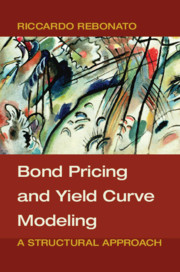Book contents
- Frontmatter
- Dedication
- Contents
- Acknowledgements
- Symbols and Abbreviations
- Part I The Foundations
- Part II The Building Blocks: A First Look
- Part III The Conditions of No-Arbitrage
- Part IV Solving the Models
- Part V The Value of Convexity
- Part VI Excess Returns
- Part VII What the Models Tell Us
- 30 The Doubly Mean-Reverting Vasicek Model
- 31 Real Yields, Nominal Yields and Inflation: The D'Amico–Kim–Wei Model
- 32 From Snapshots to Structural Models: The Diebold–Rudebusch Approach
- 33 Principal Components as State Variables of Affine Models: The PCA Affine Approach
- 34 Generalizations: The Adrian–Crump–Moench Model
- 35 An Affine, Stochastic-Market-Price-of-Risk Model
- 36 Conclusions
- References
- Index
32 - From Snapshots to Structural Models: The Diebold–Rudebusch Approach
from Part VII - What the Models Tell Us
Published online by Cambridge University Press: 25 May 2018
- Frontmatter
- Dedication
- Contents
- Acknowledgements
- Symbols and Abbreviations
- Part I The Foundations
- Part II The Building Blocks: A First Look
- Part III The Conditions of No-Arbitrage
- Part IV Solving the Models
- Part V The Value of Convexity
- Part VI Excess Returns
- Part VII What the Models Tell Us
- 30 The Doubly Mean-Reverting Vasicek Model
- 31 Real Yields, Nominal Yields and Inflation: The D'Amico–Kim–Wei Model
- 32 From Snapshots to Structural Models: The Diebold–Rudebusch Approach
- 33 Principal Components as State Variables of Affine Models: The PCA Affine Approach
- 34 Generalizations: The Adrian–Crump–Moench Model
- 35 An Affine, Stochastic-Market-Price-of-Risk Model
- 36 Conclusions
- References
- Index
Summary
THE PURPOSE OF THIS CHAPTER
In the previous chapter we have seen the strengths and weaknesses of latentvariables models. Starting with this chapter we return to specified-variable models. We do so by looking in some detail at the approach by Diebold and Rudebusch (2013), who take a ‘snapshot model’ and turn it into a dynamic affine model whose state variables can be interpreted as proxies for the Principal Components.
Since we know a lot about principal components, and they afford a ready intuition in terms of level, slope and curvature of the yield curve, this is very desirable, and facilitates the calibration of the model. Indeed, this insight will be the motivation for the Principal Component–based model presented in the next chapter. As we shall see in the next chapter, however, the transition from state variables that ‘look a bit like principal components’ to state variables that are exactly principal components is not all plain sailing.
We stress that in this chapter we give only a partial account of the Diebold– Rudebusch approach – in particular, we do not cover the important aspect of the statistical estimation of the model. This is a pity because, as Diebold and Rudebusch, say, their model
blends two important and successful approaches to yield curve modelling: the […] empirically based and the no-arbitrage theoretically based one. Yield curve models in both traditions are impressive successes, albeit for different reasons. Ironically, both approaches are equally impressive failures, and for the same reasons, swapped. That is, models in the [statistical] tradition fit and forecast well, but they […] may admit arbitrage possibilities, while the models in the arbitrage-free tradition are theoretically rigorous insofar as they enforce absence of arbitrage, but they may fit and forecast poorly.
The model presented in this chapter, the authors continue, ‘bridges the divide with a [statistically]-inspired model that enforces absence of arbitrage’.
So, our sin of omission, when we fail adequately to cover in this chapter the statistical (parameter-estimation) aspect of the model, is not a minor blemish, as it fails to do full justice to an important aspect of the Diebold–Rudebusch approach. Since, however, the econometric aspect is very well covered in the book by Diebold and Rudebusch, brevity and a tight focus on the book narrative have recommended the skewed treatment we present below.
- Type
- Chapter
- Information
- Bond Pricing and Yield Curve ModelingA Structural Approach, pp. 602 - 617Publisher: Cambridge University PressPrint publication year: 2018
- 1
- Cited by



